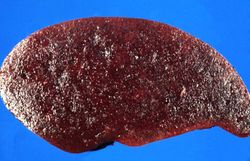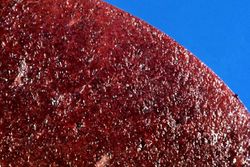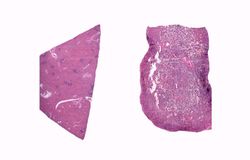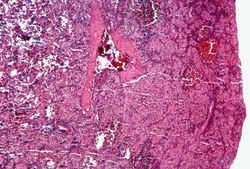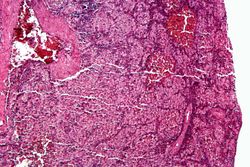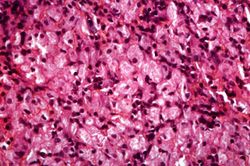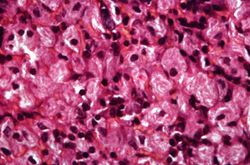Difference between revisions of "IPLab:Lab 5:Gaucher Disease"
Seung Park (talk | contribs) |
Seung Park (talk | contribs) |
||
| Line 25: | Line 25: | ||
The third pattern, type III, is usually somewhat intermediate between types I and II. These patients are usually juveniles and have systemic involvement like in type I but they have progressive central nervous system disease that usually begins in the second or third decade of life.</spoiler> | The third pattern, type III, is usually somewhat intermediate between types I and II. These patients are usually juveniles and have systemic involvement like in type I but they have progressive central nervous system disease that usually begins in the second or third decade of life.</spoiler> | ||
* <spoiler text="What type of Gaucher disease did this patient likely have?">This was an adult who had pancytopenia and aseptic necrosis of bone. This is consistent with type I. In type I symptoms and signs first appear in adult life and are related to splenomegaly or to bone involvement by Gaucher cells. These patients have pancytopenia or thrombocytopenia secondary to hypersplenism and pathologic fractures and bone pain due to expansion of the marrow space by Gaucher cells.</spoiler> | * <spoiler text="What type of Gaucher disease did this patient likely have?">This was an adult who had pancytopenia and aseptic necrosis of bone. This is consistent with type I. In type I symptoms and signs first appear in adult life and are related to splenomegaly or to bone involvement by Gaucher cells. These patients have pancytopenia or thrombocytopenia secondary to hypersplenism and pathologic fractures and bone pain due to expansion of the marrow space by Gaucher cells.</spoiler> | ||
| + | |||
| + | == Additional Resources == | ||
| + | === Reference === | ||
| + | * [http://emedicine.medscape.com/article/944157-overview eMedicine Medical Library: Gaucher Disease] | ||
| + | * [http://www.merckmanuals.com/professional/hematology_and_oncology/spleen_disorders/splenomegaly.html Merck Manual: Splenomegaly] | ||
| + | * [www.merckmanuals.com/professional/pediatrics/inherited_disorders_of_metabolism/lysosomal_storage_disorders.html Merck Manual: Lysosomal Storage Disorders] | ||
| + | |||
| + | === Journal Articles === | ||
| + | * Barone R, Pavone V, Nigro F, Chabàs A, Fiumara A. [http://www.ncbi.nlm.nih.gov/pubmed/10792292 Extraordinary bone involvement in a gaucher disease type I patient]. ''Br J Haematol'' 2000 Mar;108(4):838-41. | ||
| + | |||
| + | === Images === | ||
| + | * [http://peir.path.uab.edu/library/index.php?/tags/1670-gaucher_cell PEIR Digital Library: Gaucher Cell Images] | ||
| + | * [http://library.med.utah.edu/WebPath/HEMEHTML/HEMEIDX.html Webpath: Hematopathology] | ||
{{IPLab 5}} | {{IPLab 5}} | ||
[[Category: IPLab:Lab 5]] | [[Category: IPLab:Lab 5]] | ||
Revision as of 20:46, 22 August 2013
Contents
Clinical Summary =[edit]
This 23-year-old black female delivered a stillborn infant by Caesarean section, following which she experienced excessive uterine bleeding including the passage of blood clots. Further study revealed an enlarged spleen and thrombocytopenia (platelet count 58,000). A splenectomy was performed with an uneventful postoperative course other than persistent pain in her right leg (the right hip had been fractured 2 years earlier). Subsequently she developed aseptic necrosis of the left femoral head requiring a prosthetic replacement. Microscopic evaluation of the bone removed at the time of surgery revealed Gaucher cells in the marrow space.
Autopsy Findings[edit]
The surgical specimen was a 935-gram spleen. Its surface was pale with an area of bluish discoloration. The cut surface revealed the same pale appearance.
Images[edit]
Study Questions[edit]
Additional Resources[edit]
Reference[edit]
- eMedicine Medical Library: Gaucher Disease
- Merck Manual: Splenomegaly
- [www.merckmanuals.com/professional/pediatrics/inherited_disorders_of_metabolism/lysosomal_storage_disorders.html Merck Manual: Lysosomal Storage Disorders]
Journal Articles[edit]
- Barone R, Pavone V, Nigro F, Chabàs A, Fiumara A. Extraordinary bone involvement in a gaucher disease type I patient. Br J Haematol 2000 Mar;108(4):838-41.
Images[edit]
| |||||
The normal platelet count is 150,000 to 400,000/mm³.
Trauma (from fracture or surgery) is one cause of asceptic (or avascular) necrosis of bone, which is defined as the death of bone and bone marrow in the abscence of an infectious agent.
